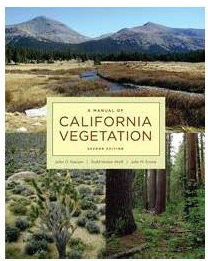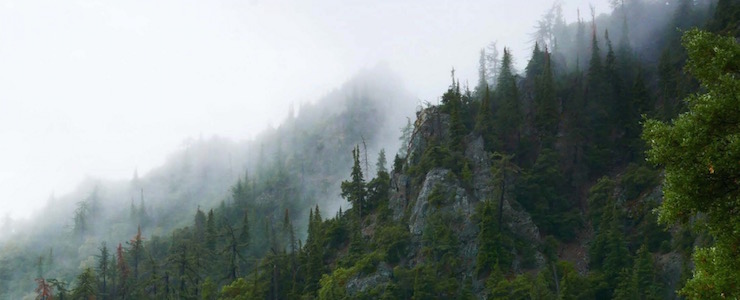California Conservation Garden and Native Plant Program
The Native Plant Program (NPP) at the UCSC Arboretum & Botanic Garden stewards and maintains the Entrance Native Garden and the California Conservation Garden, and engages student experiential learning through the Interactive Ecology Internship Program. The NPP also partners with the California Department of Fish and Wildlife on vegetation mapping and the California Plant Rescue Program on conservation through a seed saving project.
Interactive Ecology Internship

Interactive Ecology interns will work in the California Conservation Gardens, Laurasian Forest, World Conifer Garden, nursery and greenhouse areas, and with the Conservation Seed Bank in the UCSC Arboretum. Work changes with the seasons and is project dependent. There will be supplemental readings, writings, and activities, relating to the fields of conservation, botany, land stewardship, ecology and more.
Work in the gardens can include: planting, weeding invasive plants, mowing, irrigation installation and maintenance, and pruning. Work in the nurseries and greenhouses can include: repotting plants, weeding, propagation, and seed banking work. You will learn these things and more, and grow to appreciate the nuances of the work we do in the Arboretum!
Open to both 2-unit and 5-unit internships. The amount of interns we will be able to take on will be scheduling dependent.
For more information and TO APPLY, look for "Arboretum" under:
Campus Internships / Environmental Studies

Five Rare Plants of the Pine Hill Preserve: Improving Germination Success. Nicole L. Jurjavic, Rob Thoms, Brett Hall, et. al., 2018. (pdf)
California Plant Rescue: Conserving botanical diversity through collections, monitoring, and research. Stacy Anderson, Cheryl Birker, Holly Forbes, et. al., 2018. (pdf)
"Cross-lineage hybridization in the genus Arctostaphylos (Ericaceae)", by Eric Van Dyke, Reed College Bio 332 (May 2017).
California Chapparal Institute. The best source of accurate information about native shrub land communities and California's most extensive ecosystem.
Friends of the Chico State Herbarium.
The Jepson Herbarium, University of California, Berkeley. Recent News from the Jepson Herbarium: Revision 4 of the Jepson eFlora is now online.
Videos from the 2017 Northern California Botanists Symposium, 9-10 January. "DIVERSE ENVIRONMENTS: HOW PLANTS SUCCEED IN NORTHERN CALIFORNIA." Stephen Rosenthal, Santa Clara Chapter, CNPS Past President, was the videographer. Symposium was sponsored by Northern California Botanists.
1. Carex xerophila – a new sedge hiding in the chaparral.
2. New bryophyte discoveries in California: The frontier remains.
3. Cryptic host-specific diversity in the newly resurrected parasitic genus Aphyllon.
4. Chaparral seed banks: Not just for plants anymore.
5. Soil seed banks of native and exotic forbs in restored and reference northern coastal prairies.
6. Response of soil seed banks to drought in California annual grasslands.
7. Soil seed banks of a federally listed Threatened annual plant, Camissonia benitensis.
8. Collaboration and adaptive management precludes federal listing of Tahoe yellow cress.
9. A place for plants in FERC licensed hydropower projects.
10. Year of the Monkey: A rare “super bloom” for Carson Valley Monkeyflower.
11.To create a botanic garden.
12. Biogeographical wanderings in the Streptanthus howellii Alliance.
13. Pinus ponderosa: A checkered past obscured four species.
14. In search of alpine rarity: A “Rare Plant Treasure Hunt” in Yosemite National Park.
15. Fear and loathing in the Sierra Nevada: Confronting a wicked problem.
16. Pines and pine bark beetles in California: A legacy of diversity and damage.
17. Gallwasps on California Oaks.
18. Flies—the forgotten pollinators.
19. Influence of coastal fog on endemism on the Central Coast of California.
20. Lichens in the mist: Investigating California’s fog lichens.
21. Impact of historic drought on the population dynamics of a fog-influenced coastal forest.
22. Varied species responses to fog in the coast redwood ecosystem.
23. Influence of Summer Fog on Patterns of Plant Diversity.
24. Jepson Prairie Preserve: 35 years of conservation, research, and public education.
25. The spicebush and the wasp.
26. Calflora, a tool for botanists and plant enthusiasts.
27. Carbonate substrates: Plant associations and climate impacts.
28. Gabbro and beyond.
29. Some questions we need answered about California plants and climate change.
"Pinus ponderosa: A checkered past obscured four species." By Ann Willyard, et.al. American Journal of Botany, 104(1):1-21, 2017. Recent genetic studies separate out local Santa Cruz Ponderosa Pines, like those in the Arboretum, as Pinus benthemaniana.
"Fostered by Fog", a recent article in UCSC's online journal Science Notes, uses the example of 'maritime chaparral' to explore the collaboration among the Arboretum's Native Plant Program, UCSC and the California Native Plant Society in preserving threatened native California plants. The article is written by Amy McDermott and beautifully illustrated by Yvonne Byers.
The late Bob Haller and his work on Pinus ponderosa var. pacifica (one of the Arboretum’s mascot species for the NPP): "John Robert (Bob) Haller, (was a) renowned California Botanist, inspirational teacher, and mentor to so many of us. Bob was international recognized for his work on pines but may be most remembered for the way he joyfully shared his love of the natural world with the rest of us - inspiring generations of botanists and avid naturalists." Read more.
Now available: Information about the Arboretum's California Province Garden, including plans and maps:
-
View a map (PDF) of the California Native Conservation Gardens
-
Read "Traversing Swanton," an essay on Scotts Creek Watershed (PDF) by James A. West. Revised 2-22-16 or visit a website derived from James West's essay (above) describing the Scotts Creek watershed area.
- Read Research Topics for the Scott Creek Watershed and Environs (PDF) by James A. West. Edited by Dylan Neubauer, December 2015.
- View a (PDF) of Ethnobotany: uses of California Plants
- A Key to the Willows of Santa Cruz County (PDF) by members of the California Native Plant Society and edited by Randy Morgan.
- 'Ecosystems of California' documents one of Earth's most biodiverse places', with contributions from 19 authors with ties to UC Santa Cruz.
- UCSC Arboretum California Native Plant Conservation Garden Recommendations

